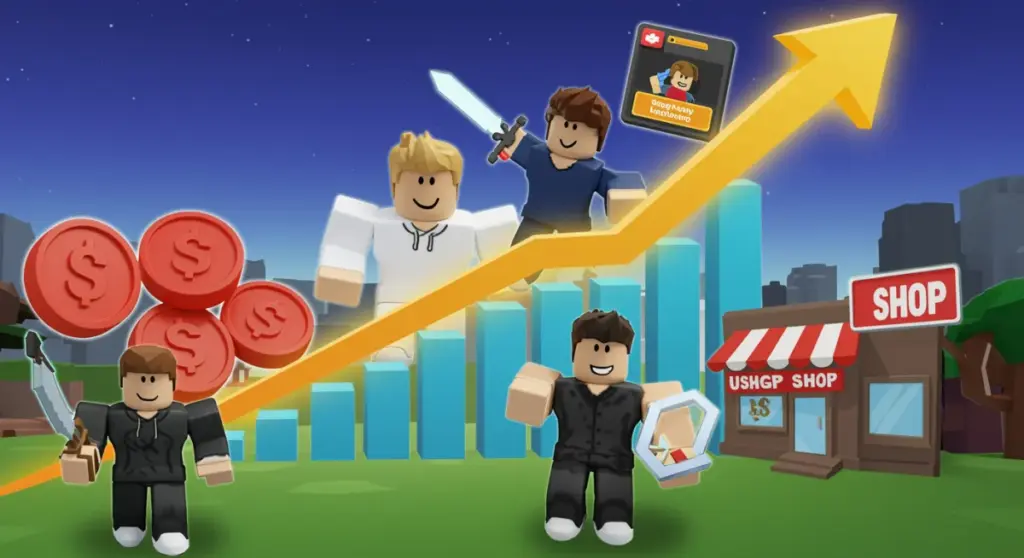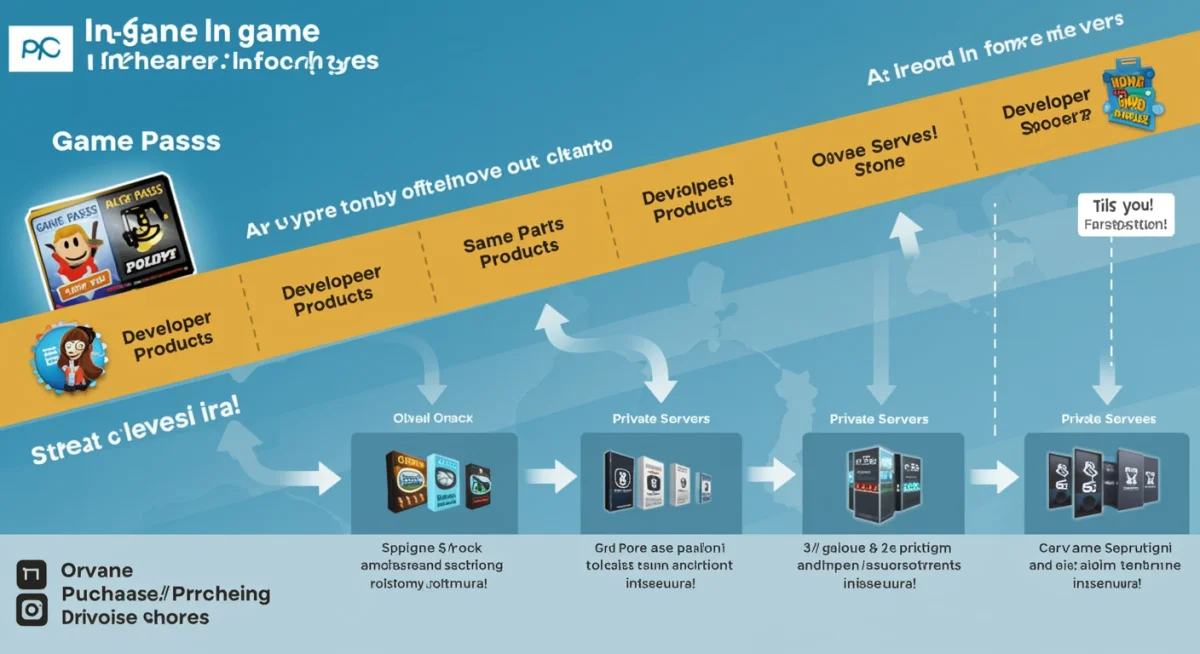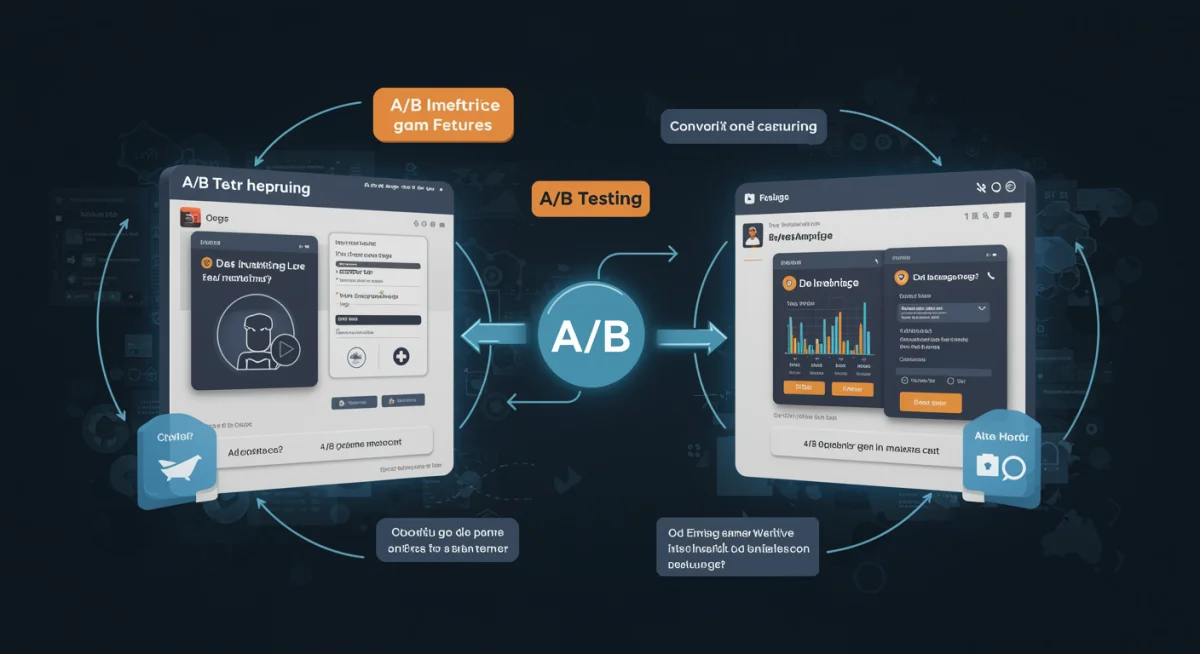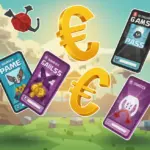Roblox Monetization Strategies: Increase Your Revenue by 40% in 6 Months

Anúncios
Implementing sophisticated Roblox monetization strategies can significantly elevate your game’s revenue, with developers often achieving a 40% increase within half a year by optimizing in-game transactions and player engagement.
Are you a Roblox developer looking to transform your passion into a profitable venture? Understanding and implementing effective Roblox monetization strategies is crucial for sustained growth and financial success. This comprehensive guide will walk you through proven methods to significantly boost your game’s revenue, aiming for an impressive 40% increase in just six months.
Understanding the Roblox Economy
The Roblox economy is a dynamic ecosystem driven by Robux, the platform’s virtual currency. Players acquire Robux through various means, including direct purchase, Roblox Premium subscriptions, and earning through game development. For developers, this creates a direct channel to monetize their creations. Successful monetization hinges on understanding player behavior, perceived value, and the mechanics of in-game transactions within this unique environment.
The platform offers a robust set of tools and features that allow creators to integrate monetization seamlessly into their experiences. This isn’t just about selling items; it’s about creating value that players genuinely want to engage with and pay for. A deep dive into the Roblox economy reveals that user engagement is directly proportional to monetization potential, meaning the more players enjoy and interact with your game, the higher the likelihood of them spending Robux.
The role of Robux in monetization
Robux serves as the lifeblood of the Roblox economy, facilitating all transactions. Developers earn Robux when players purchase their game passes, developer products, or access to paid access games. Converting Robux back into real-world currency is possible through the Developer Exchange (DevEx) program, making the virtual currency a tangible asset for creators.
- Direct purchases: Players buy Robux directly from Roblox.
- Roblox Premium: Subscribers receive a monthly Robux stipend and exclusive perks.
- Developer Exchange: Developers convert earned Robux into USD.
Understanding the Robux exchange rate and how it impacts your earnings is critical for setting pricing strategies. Factors like regional pricing and player demographics can influence the perceived value of Robux and, consequently, your in-game items. Therefore, constant monitoring and adjustment are necessary to optimize your revenue streams effectively.
In conclusion, a clear grasp of the Roblox economy, particularly the flow and value of Robux, forms the bedrock of any successful monetization strategy. Developers must align their in-game offerings with player expectations and the platform’s economic realities to maximize their earning potential.
Optimizing Game Passes and Developer Products
Game passes and developer products are fundamental components of Roblox monetization strategies. Game passes offer permanent access to special abilities, items, or areas within your game, providing long-term value. Developer products, on the other hand, are consumable items that players can purchase multiple times, such as in-game currency, power-ups, or temporary boosts. The key to optimizing these lies in strategic pricing, clear value proposition, and seamless integration into the gameplay experience.
Many developers make the mistake of simply adding these items without careful consideration of their impact on gameplay or player psychology. Effective optimization involves understanding what motivates your players to spend and how these purchases enhance their experience without creating a ‘pay-to-win’ scenario that alienates your audience. It’s about finding the sweet spot where value meets accessibility.


Strategic pricing for maximum conversion
Pricing your game passes and developer products requires a delicate balance. Too high, and you risk deterring potential buyers; too low, and you might undervalue your offerings. A common strategy involves tiered pricing, offering different versions of an item at varying price points to cater to diverse player budgets and needs.
- Entry-level items: Affordable options to encourage initial purchases.
- Mid-tier items: Offer significant value for a moderate price.
- Premium items: High-value, exclusive offerings for dedicated players.
Consider running A/B tests on different price points to see what resonates best with your community. Analyze sales data to identify trends and adjust your pricing accordingly. Remember, perceived value is often more important than the actual cost. Clearly communicate the benefits of each purchase to justify the price.
Seamless integration means that purchasing these items feels natural and enhances the game, rather than disrupting it. For example, a game pass for a VIP area should offer unique experiences, not just a label. Developer products like extra lives should be available at critical moments, making the purchase feel like a helpful solution rather than a forced transaction. By focusing on value and thoughtful integration, you can significantly boost your game pass and developer product sales.
Leveraging Engaged Player Communities
An engaged player community is a goldmine for effective Roblox monetization strategies. Players who feel connected to your game and its community are far more likely to spend Robux, recommend your game to others, and provide valuable feedback. Building and nurturing this community involves consistent communication, active moderation, and creating opportunities for players to interact with each other and with you, the developer.
Beyond just playing, community members often become ambassadors for your game. They create fan content, participate in discussions, and even help new players. Recognizing and rewarding these dedicated individuals can further solidify their loyalty and encourage others to become more involved. This organic growth and engagement are far more powerful than any paid advertising campaign.
Community events and exclusive content
Running regular in-game events and offering exclusive content to your most dedicated players can significantly boost engagement and monetization. These events create a sense of urgency and excitement, encouraging players to log in and participate, often leading to increased Robux spending for event-specific items or advantages.
- Limited-time events: Introduce unique challenges and rewards.
- Exclusive cosmetics: Offer rare outfits or accessories for loyal players.
- Developer Q&A sessions: Build rapport and gather feedback directly.
Consider creating a Discord server or a dedicated group on Roblox for your community. These platforms allow for direct interaction, quick announcements, and a space for players to share their experiences. Listening to feedback and implementing player suggestions not only improves your game but also makes players feel valued and heard, fostering a stronger sense of ownership and loyalty. A strong community doesn’t just play your game; they invest in its success.
Implementing Effective A/B Testing
A/B testing is a powerful tool in refining your Roblox monetization strategies. It involves creating two versions of a game feature, pricing model, or user interface element, and then presenting them to different segments of your player base to see which performs better. This data-driven approach removes guesswork, allowing you to make informed decisions that directly impact your revenue. Without A/B testing, you’re essentially guessing what your players prefer, which can lead to missed opportunities or even negative impacts on monetization.
The beauty of A/B testing lies in its scientific approach. By isolating variables, you can pinpoint exactly what changes lead to improvements in key metrics such as conversion rates, average revenue per user (ARPU), and player engagement. This iterative process of testing, analyzing, and implementing changes is crucial for continuous optimization and achieving that 40% revenue increase.


Key areas for A/B testing in Roblox
There are numerous aspects of your Roblox game where A/B testing can yield significant insights. Focusing on elements directly related to monetization will provide the most impactful results.
- Pricing of game passes and developer products: Test different Robux amounts for your items.
- Shop UI layout and design: Optimize discoverability and appeal of your in-game store.
- Promotional banners and pop-ups: Evaluate effectiveness of various calls to action.
- Tutorial flows for new players: See if different onboarding experiences affect early purchases.
When conducting A/B tests, ensure your sample sizes are statistically significant and that you run the tests for an adequate duration to gather reliable data. Use analytics tools to track key performance indicators (KPIs) and always focus on one variable at a time to accurately attribute changes in results. Document your findings to build a knowledge base of what works and what doesn’t for your specific game and audience. This systematic approach to optimization is what separates successful monetization from mere chance.
In essence, A/B testing empowers developers to continuously refine their monetization strategies based on real player behavior. It’s a proactive method for identifying opportunities for growth and ensuring that every change implemented is backed by data, leading to more predictable and sustainable revenue increases.
Enhancing Player Retention and Engagement
Player retention and engagement are inextricably linked to successful Roblox monetization strategies. A game with high retention means players are returning frequently, spending more time in your experience, and consequently, are more likely to make purchases. Engagement goes beyond mere playtime; it encompasses how deeply players interact with your game’s features, community, and content. Low retention means you’re constantly fighting to attract new players, which is often more expensive and less effective than retaining existing ones.
To truly boost revenue by 40% in six months, you must prioritize making your game a place players want to revisit repeatedly. This involves creating compelling content, fostering a sense of progression, and ensuring a smooth, enjoyable user experience. Think of it as building a loyal customer base that consistently supports your product.
Strategies for long-term player engagement
Keeping players engaged over the long term requires a multi-faceted approach. It’s not just about flashy new updates; it’s about building a sustainable loop of content, community, and reward. Effective strategies often involve dynamic content and social features.
- Regular content updates: Introduce new maps, modes, items, or quests to keep the game fresh.
- Daily/weekly rewards: Incentivize consistent logins with bonuses and exclusive items.
- Social features: Implement robust chat systems, friend lists, and group functionalities.
- Progression systems: Offer clear goals, leveling systems, and achievements that provide a sense of accomplishment.
Furthermore, consider implementing seasonal events or themed updates that align with real-world holidays or popular trends. These can generate significant spikes in player activity and, by extension, monetization. Personalization also plays a role; allowing players to customize their avatars, bases, or items can deepen their connection to your game. By consistently providing reasons for players to return and engage, you build a loyal audience more inclined to invest in your game’s ecosystem.
Ultimately, a highly retained and engaged player base forms the bedrock of a successful monetization model. Investing in features and strategies that keep players coming back not only enhances their experience but also creates numerous opportunities for organic and sustainable revenue growth.
Analyzing Data and Iterating for Growth
Data analysis is the compass guiding your Roblox monetization strategies towards that 40% revenue increase. Without understanding what’s working and what isn’t, your efforts are based on assumptions. Roblox provides developers with robust analytics tools that track player behavior, purchase patterns, and engagement metrics. Regularly diving into this data allows you to identify trends, pinpoint areas for improvement, and validate the effectiveness of your implemented changes.
The iterative process of analyze-plan-execute-evaluate is fundamental. It’s not a one-time setup; it’s a continuous cycle of refinement. Successful developers constantly monitor their game’s performance, adapt their strategies, and aren’t afraid to pivot when the data suggests a different direction. This agile approach ensures your monetization efforts remain relevant and optimized for your evolving player base.
Key metrics to monitor for monetization success
To effectively analyze your game’s performance and identify monetization opportunities, focus on several key metrics. These indicators provide a clear picture of your game’s health and the efficacy of your strategies.
- Average Revenue Per User (ARPU): Measures the average revenue generated from each active player.
- Conversion Rate: Percentage of players who make at least one purchase.
- Retention Rates: How many players return to your game over specific periods (e.g., daily, weekly).
- Lifetime Value (LTV): The total revenue expected from a player over their entire engagement with your game.
- Sales of specific items: Identify which game passes or developer products are most popular.
Beyond these quantitative metrics, qualitative data from player feedback, surveys, and community discussions can offer invaluable insights into player sentiment and unmet needs. Combine both types of data for a holistic view. For example, if ARPU is low but retention is high, it might suggest your items are either too expensive or not providing enough perceived value. Iterating based on these insights, by adjusting prices, improving item descriptions, or adding new desirable content, is how you drive sustained revenue growth.
In essence, data is your most powerful ally in optimizing monetization. By consistently analyzing performance, identifying patterns, and making data-backed decisions, you can systematically refine your strategies, ensuring your game not only attracts players but also effectively converts their engagement into substantial revenue.
Future-Proofing Your Monetization
To ensure your Roblox monetization strategies continue to yield results beyond the initial six-month boost, it’s essential to think about future-proofing. The Roblox platform, like any digital ecosystem, is constantly evolving. New features are introduced, player preferences shift, and competition intensifies. A static monetization strategy will inevitably become outdated. Future-proofing involves staying adaptable, innovative, and deeply connected to both the platform’s developments and your player base’s changing desires.
This forward-thinking approach means not just reacting to changes but anticipating them. It involves dedicating resources to research and development, experimenting with new monetization models, and fostering a culture of continuous improvement within your development team. Longevity in the Roblox ecosystem is achieved through foresight and flexibility.
Staying ahead: trends and innovation
Keeping an eye on emerging trends in the gaming industry and within Roblox specifically can provide a significant competitive edge. This includes understanding new forms of user-generated content, evolving social mechanics, and advanced customization options. Innovation in how you present and sell your content can unlock new revenue streams.
- Explore new Roblox features: Integrate new platform capabilities that enhance monetization.
- Cross-promotion: Collaborate with other developers to expand your audience and potential spenders.
- Subscription models: Consider offering exclusive content or perks through a recurring Robux payment.
- User-generated content (UGC) integration: Allow players to create and sell their own items within your game, taking a commission.
Furthermore, actively participating in the Roblox developer community can provide insights into what other successful creators are doing. Learning from their successes and failures can inform your own strategies. Regularly solicit feedback from your players about what they would like to see, both in terms of gameplay and monetization options. By being proactive, innovative, and player-centric, you can build a monetization strategy that not only achieves short-term gains but also ensures long-term success and adaptability in the ever-changing world of Roblox. This continuous evolution is key to maintaining and even exceeding that 40% revenue increase over time.
| Key Strategy | Brief Description |
|---|---|
| Optimize In-Game Products | Strategically price Game Passes and Developer Products, ensuring clear value and seamless integration. |
| Build Community | Foster engagement through events, exclusive content, and active communication channels to build loyalty. |
| Implement A/B Testing | Use data-driven experiments for pricing, UI, and promotions to identify optimal monetization approaches. |
| Analyze Data & Iterate | Continuously monitor key metrics like ARPU and conversion rates to refine and adapt strategies. |
Frequently Asked Questions About Roblox Monetization
Developers primarily earn Robux through game passes, which grant permanent in-game advantages or items, and developer products, which are consumable items like power-ups or in-game currency. Paid access games, requiring a one-time Robux fee to play, also contribute to earnings.
To boost ARPU, focus on creating high-value, desirable in-game items and experiences. Implement tiered pricing, offer limited-time bundles, and ensure your shop UI is intuitive. Regularly update content to keep players engaged and willing to spend more.
Yes, A/B testing is vital. It allows you to scientifically compare different versions of pricing, UI layouts, or promotional messages to see which performs best with your audience. This data-driven approach removes guesswork and optimizes your strategies for maximum revenue.
Community engagement is a cornerstone of successful monetization. Loyal players who feel connected to your game are more likely to make purchases, provide feedback, and promote your game. Foster engagement through events, social features, and direct communication.
Monetization strategies should be reviewed and updated continuously. The Roblox platform and player preferences are always evolving. Regular data analysis, A/B testing, and staying informed about new trends ensure your strategy remains effective and profitable over time.
Conclusion
Achieving a 40% increase in revenue within six months through strategic Roblox monetization strategies is an ambitious yet entirely attainable goal for dedicated developers. By deeply understanding the Roblox economy, optimizing your in-game products, nurturing a vibrant player community, and making data-driven decisions through A/B testing and continuous analytics, you can transform your game’s financial performance. Remember, success on Roblox is not just about creating a fun experience, but also about intelligently structuring how that experience generates value for both players and creators. Embrace innovation, stay connected to your community, and always be prepared to adapt your approach to maintain sustainable growth and maximize your earnings on this dynamic platform.





